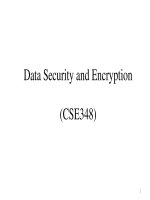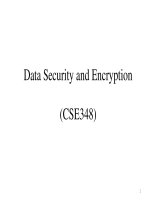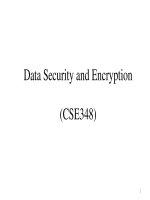Lecture Data communications and networks: Chapter 20 - Forouzan
Bạn đang xem bản rút gọn của tài liệu. Xem và tải ngay bản đầy đủ của tài liệu tại đây (1.48 MB, 52 trang )
Chapter 20
Network Layer:
Internet Protocol
20.1
Copyright © The McGrawHill Companies, Inc. Permission required for reproduction or display.
20-1 INTERNETWORKING
In this section, we discuss internetworking, connecting
networks together to make an internetwork or an
internet.
Topics discussed in this section:
Need for Network Layer
Internet as a Datagram Network
Internet as a Connectionless Network
20.2
Figure 20.1 Links between two hosts
20.3
Figure 20.2 Network layer in an internetwork
20.4
Figure 20.3 Network layer at the source, router, and destination
20.5
Figure 20.3 Network layer at the source, router, and destination (continued)
20.6
Note
Switching at the network layer in the
Internet uses the datagram approach to
packet switching.
20.7
Note
Communication at the network layer in
the Internet is connectionless.
20.8
20-2 IPv4
The Internet Protocol version 4 (IPv4) is the delivery
mechanism used by the TCP/IP protocols.
Topics discussed in this section:
Datagram
Fragmentation
Checksum
Options
20.9
Figure 20.4 Position of IPv4 in TCP/IP protocol suite
20.10
Figure 20.5 IPv4 datagram format
20.11
Figure 20.6 Service type or differentiated services
20.12
Note
The precedence subfield was part of
version 4, but never used.
20.13
Table 20.1 Types of service
20.14
Table 20.2 Default types of service
20.15
Table 20.3 Values for codepoints
20.16
Note
The total length field defines the total
length of the datagram including the
header.
20.17
Figure 20.7 Encapsulation of a small datagram in an Ethernet frame
20.18
Figure 20.8 Protocol field and encapsulated data
20.19
Table 20.4 Protocol values
20.20
Example 20.1
An IPv4 packet has arrived with the first 8 bits as shown:
01000010
The receiver discards the packet. Why?
Solution
There is an error in this packet. The 4 leftmost bits (0100)
show the version, which is correct. The next 4 bits (0010)
show an invalid header length (2 × 4 = 8). The minimum
number of bytes in the header must be 20. The packet has
been corrupted in transmission.
20.21
Example 20.2
In an IPv4 packet, the value of HLEN is 1000 in binary.
How many bytes of options are being carried by this
packet?
Solution
The HLEN value is 8, which means the total number of
bytes in the header is 8 × 4, or 32 bytes. The first 20 bytes
are the base header, the next 12 bytes are the options.
20.22
Example 20.3
In an IPv4 packet, the value of HLEN is 5, and the value
of the total length field is 0x0028. How many bytes of
data are being carried by this packet?
Solution
The HLEN value is 5, which means the total number of
bytes in the header is 5 × 4, or 20 bytes (no options). The
total length is 40 bytes, which means the packet is
carrying 20 bytes of data (40 − 20).
20.23
Example 20.4
An IPv4 packet has arrived with the first few hexadecimal
digits as shown.
0x45000028000100000102 . . .
How many hops can this packet travel before being
dropped? The data belong to what upperlayer protocol?
Solution
To find the time-to-live field, we skip 8 bytes. The time-tolive field is the ninth byte, which is 01. This means the
packet can travel only one hop. The protocol field is the
next byte (02), which means that the upper-layer protocol
is IGMP.
20.24
Figure 20.9 Maximum transfer unit (MTU)
20.25









